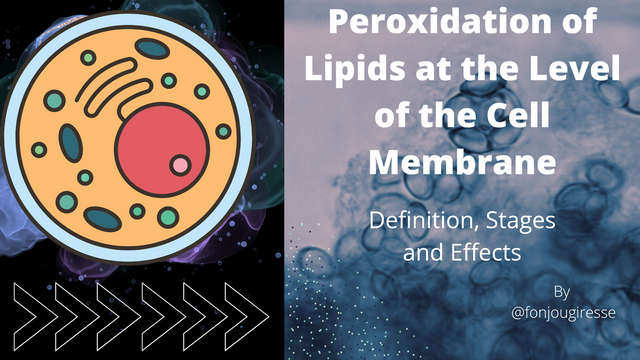[Club 100] Lipid Peroxydation and it's Effects on the Cell Membrane
Greetings fellow Steemian I am sorry for my absence but here I come again. last time we ended with sphingolipids, giving the name of abnormality and how it originated, today we are going to continue with lipids but this time were are going to see their peroxidation (a brief definition, the stages and it effects).

Designed on Canva
Peroxidation of membrane lipids.
Lipid peroxidation is the oxidative degradation of lipids. Peroxidases catalyse the oxidation of lipids using hydrogen peroxide as an electron acceptor. In this process, free radicals capture electrons from plasma membrane lipids and cause cellular damage.
Peroxidation of membrane lipids by oxygen free radicals is likely to cause membrane damage and lead to cell death. Lipid peroxidation particularly affects polyunsaturated fatty acids because they contain several unsaturated double bonds in which unsaturated methylene groups (-CH2-) have reactive hydrogen atoms that can donate an electron (reducing).

SourceDifferent Types of Lipids; Lipids are Biomacro-molecules compose of hydrophilic( water loving) heads and hydphobic(water hater) tails.
Lipid peroxidation has several stages: initiation, propagation, and termination. During initiation, a fatty acid radical is produced. For living cells, the initiator is probably an oxygen derivative (reactive oxygen species or ROS), such as the hydroxyl anion OH-, which combines with an H+ to form water and a fatty acid radical. The latter is not a very stable molecule and reacts with oxygen to form a peroxyl fatty acid radical, which is also unstable. This reacts with another fatty acid to produce another fatty acid radical and hydrogen peroxide or cyclic peroxide if it reacts with itself. This cycle continues as long as the newly formed fatty acid radical reacts in the same way, forming a chain reaction (propagation). This reaction ends when two fatty acid radicals react to form a non-radical molecule (Termination).
This event occurs when the concentration of radical molecules is high enough that the probability of two radicals reacting is high.
Living organisms have produced various molecules that accelerate termination by scavenging free radicals and thus protect cell membranes. One such molecule is alpha-tocopherol (or vitamin E). Other antioxidant molecules are enzymes such as superoxide dismutase, catalase, and peroxidase that act on oxygen derivatives.
Effects of Lipid Peroxidation
If the termination is not completed soon enough, lipid peroxidation can lead to damage to cell plasma membranes. For example, phototherapy can lead to the rupture of red blood cell membranes. Furthermore, the end products of lipid peroxidation can be mutagenic and carcinogenic. For example, the end product malondialdehyde reacts with deoxyadenosine and deoxyguanosine residues in DNA, forming DNA adducts, in particular M1G.
Here marks the end of our abnormalities of the membrane at the lipid level.
Upvoted! Thank you for supporting witness @jswit.

Please check my new project, STEEM.NFT. Thank you!
Good day bro you have made a really nice post that shares some very valuable knowledge,
I fear your post might be skipped as you didn't add the learnwithsteem tag
Since this is a post about sharing knowledge it would be wise to include both fintech and learnwithsteem
Ohhhh thank you for the hint but is it not prohibited to put two tags from 2 different teams?
Plagiarized content found.
Always run your content via a plagiarism check before posting, so as to avoid your hard work being muted and not getting any vote.
You could use this to always check the originality of your post before publishing it.
https://smallseotools.com/plagiarism-checker/